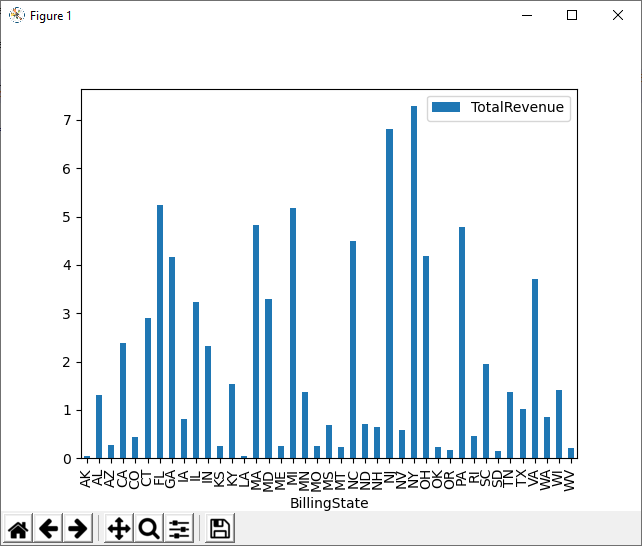Model Context Protocol (MCP) finally gives AI models a way to access the business data needed to make them really useful at work. CData MCP Servers have the depth and performance to make sure AI has access to all of the answers.
Try them now for free →How to Visualize Odoo Data in Python with pandas
Use pandas and other modules to analyze and visualize live Odoo data in Python.
The rich ecosystem of Python modules lets you get to work quickly and integrate your systems more effectively. With the CData Python Connector for Odoo, the pandas & Matplotlib modules, and the SQLAlchemy toolkit, you can build Odoo-connected Python applications and scripts for visualizing Odoo data. This article shows how to use the pandas, SQLAlchemy, and Matplotlib built-in functions to connect to Odoo data, execute queries, and visualize the results.
With built-in optimized data processing, the CData Python Connector offers unmatched performance for interacting with live Odoo data in Python. When you issue complex SQL queries from Odoo, the driver pushes supported SQL operations, like filters and aggregations, directly to Odoo and utilizes the embedded SQL engine to process unsupported operations client-side (often SQL functions and JOIN operations).
About Odoo Data Integration
Accessing and integrating live data from Odoo has never been easier with CData. Customers rely on CData connectivity to:
- Access live data from both Odoo API 8.0+ and Odoo.sh Cloud ERP.
-
Extend the native Odoo features with intelligent handling of many-to-one, one-to-many, and many-to-many data properties. CData's connectivity solutions also intelligently handle complex data properties within Odoo. In addition to columns with simple values like text and dates, there are also columns that contain multiple values on each row. The driver decodes these kinds of values differently, depending upon the type of column the value comes from:
- Many-to-one columns are references to a single row within another model. Within CData solutions, many-to-one columns are represented as integers, whose value is the ID to which they refer in the other model.
- Many-to-many columns are references to many rows within another model. Within CData solutions, many-to-many columns are represented as text containing a comma-separated list of integers. Each value in that list is the ID of a row that is being referenced.
- One-to-many columns are references to many rows within another model - they are similar to many-to-many columns (comma-separated lists of integers), except that each row in the referenced model must belong to only one in the main model.
- Use SQL stored procedures to call server-side RFCs within Odoo.
Users frequently integrate Odoo with analytics tools such as Power BI and Qlik Sense, and leverage our tools to replicate Odoo data to databases or data warehouses.
Getting Started
Connecting to Odoo Data
Connecting to Odoo data looks just like connecting to any relational data source. Create a connection string using the required connection properties. For this article, you will pass the connection string as a parameter to the create_engine function.
To connect, set the Url to a valid Odoo site, User and Password to the connection details of the user you are connecting with, and Database to the Odoo database.
Follow the procedure below to install the required modules and start accessing Odoo through Python objects.
Install Required Modules
Use the pip utility to install the pandas & Matplotlib modules and the SQLAlchemy toolkit:
pip install pandas pip install matplotlib pip install sqlalchemy
Be sure to import the module with the following:
import pandas import matplotlib.pyplot as plt from sqlalchemy import create_engine
Visualize Odoo Data in Python
You can now connect with a connection string. Use the create_engine function to create an Engine for working with Odoo data.
engine = create_engine("odoo:///?User=MyUser&Password=MyPassword&URL=http://MyOdooSite/&Database=MyDatabase")
Execute SQL to Odoo
Use the read_sql function from pandas to execute any SQL statement and store the resultset in a DataFrame.
df = pandas.read_sql("SELECT name, email FROM res_users WHERE id = '1'", engine)
Visualize Odoo Data
With the query results stored in a DataFrame, use the plot function to build a chart to display the Odoo data. The show method displays the chart in a new window.
df.plot(kind="bar", x="name", y="email") plt.show()

Free Trial & More Information
Download a free, 30-day trial of the CData Python Connector for Odoo to start building Python apps and scripts with connectivity to Odoo data. Reach out to our Support Team if you have any questions.
Full Source Code
import pandas
import matplotlib.pyplot as plt
from sqlalchemy import create_engin
engine = create_engine("odoo:///?User=MyUser&Password=MyPassword&URL=http://MyOdooSite/&Database=MyDatabase")
df = pandas.read_sql("SELECT name, email FROM res_users WHERE id = '1'", engine)
df.plot(kind="bar", x="name", y="email")
plt.show()

